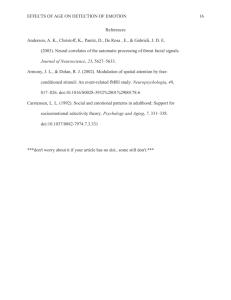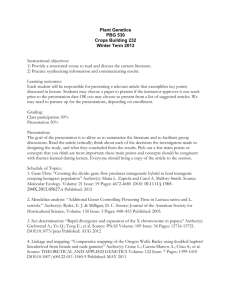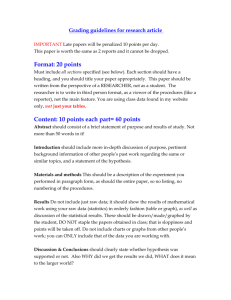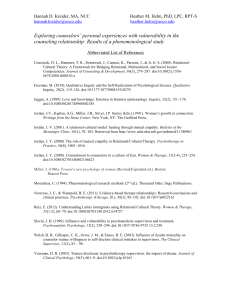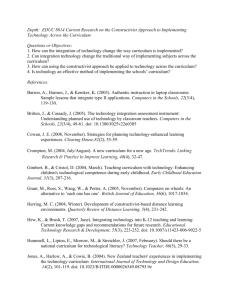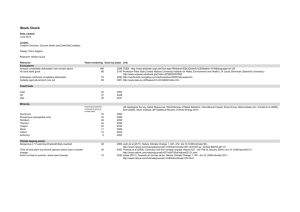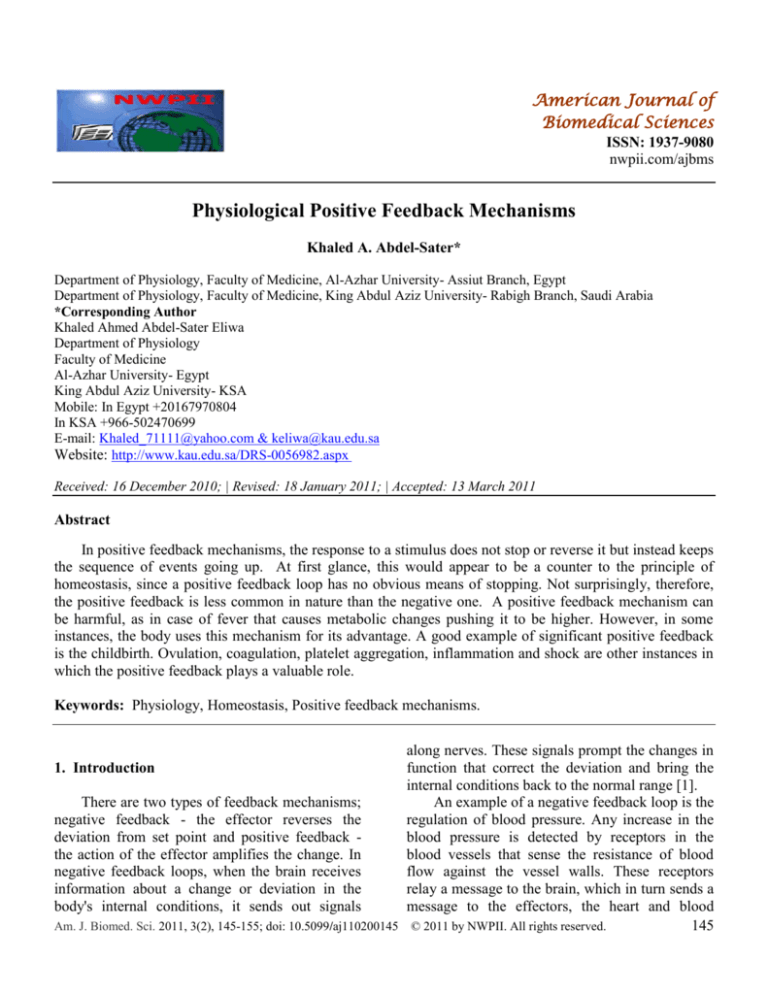
American Journal of
Biomedical Sciences
ISSN: 1937-9080
nwpii.com/ajbms
Physiological Positive Feedback Mechanisms
Khaled A. Abdel-Sater*
Department of Physiology, Faculty of Medicine, Al-Azhar University- Assiut Branch, Egypt
Department of Physiology, Faculty of Medicine, King Abdul Aziz University- Rabigh Branch, Saudi Arabia
*Corresponding Author
Khaled Ahmed Abdel-Sater Eliwa
Department of Physiology
Faculty of Medicine
Al-Azhar University- Egypt
King Abdul Aziz University- KSA
Mobile: In Egypt +20167970804
In KSA +966-502470699
E-mail: Khaled_71111@yahoo.com & keliwa@kau.edu.sa
Website: http://www.kau.edu.sa/DRS-0056982.aspx
Received: 16 December 2010; | Revised: 18 January 2011; | Accepted: 13 March 2011
Abstract
In positive feedback mechanisms, the response to a stimulus does not stop or reverse it but instead keeps
the sequence of events going up. At first glance, this would appear to be a counter to the principle of
homeostasis, since a positive feedback loop has no obvious means of stopping. Not surprisingly, therefore,
the positive feedback is less common in nature than the negative one. A positive feedback mechanism can
be harmful, as in case of fever that causes metabolic changes pushing it to be higher. However, in some
instances, the body uses this mechanism for its advantage. A good example of significant positive feedback
is the childbirth. Ovulation, coagulation, platelet aggregation, inflammation and shock are other instances in
which the positive feedback plays a valuable role.
Keywords: Physiology, Homeostasis, Positive feedback mechanisms.
along nerves. These signals prompt the changes in
function that correct the deviation and bring the
1. Introduction
internal conditions back to the normal range [1].
There are two types of feedback mechanisms;
An example of a negative feedback loop is the
negative feedback - the effector reverses the
regulation of blood pressure. Any increase in the
deviation from set point and positive feedback blood pressure is detected by receptors in the
the action of the effector amplifies the change. In
blood vessels that sense the resistance of blood
negative feedback loops, when the brain receives
flow against the vessel walls. These receptors
information about a change or deviation in the
relay a message to the brain, which in turn sends a
body's internal conditions, it sends out signals
message to the effectors, the heart and blood
Am. J. Biomed. Sci. 2011, 3(2), 145-155; doi: 10.5099/aj110200145 © 2011 by NWPII. All rights reserved.
145
vessels. The heart rate decreases and blood vessels
increase in diameter, which cause the blood
pressure to fall back within the normal range.
Conversely, if blood pressure decreases, the
receptors relay a message to the brain, which in
turn causes the heart rate to increase, and the
blood vessels to decrease in diameter [2].
In some cases, the metabolic parameter
regulated by a hormone (e.g., plasma glucose
concentration) rather than the hormone itself
represents the feedback signal. For example,
glucagon increases blood glucose level (while
insulin decreases it), which in turn inhibits the
secretion of glucagon (and stimulates that of
insulin). Neuronal signals can also serve as
feedback (neuroendocrine feedback) used, for
example, to regulate plasma osmolality [3].
Positive feedback mechanisms are designed to
accelerate or enhance ongoing output that has
been activated by a stimulus. Unlike negative
feedback mechanisms that are initiated to maintain
or regulate conditions within a set and narrow
range, positive feedback mechanisms ‗push‘ levels
beyond normal ranges. Clearly, if unchecked,
positive feedback can lead to a vicious cycle and
dangerous situations. Thus, positive feedback
mechanisms require an external brake to terminate
them [4]. Sometimes, it is the physician‘s task to
interrupt such a positive-feedback loop [5].
Several
examples
of positive feedback
mechanisms will be given.
2. Positive Feedback Effect of Estrogen before
Ovulation—the Preovulatory LH Surge
GnRH (gonadotropin releasing hormone)
stimulates the secretion of the pituitary
gonadotropins; LH (luteinizing hormone) and FSH
(follicle stimulating hormone). During the female
reproductive cycle, ovarian estradiol exerts
negative feedback to reduce gonadotropin release
[6]. However, in the late follicular phase (2 days
before ovulation), and in response to sustained
high levels of estradiol from preovulatory
follicles, the action of estradiol switches from
negative to positive feedback, resulting in a surge
release of GnRH, that is likely due to increased
GnRH neuron firing activity. Estradiol sensitizes
the pituitary to GnRH and enhances the selfAm. J. Biomed. Sci. 2011, 3(2), 145-155; doi: 10.5099/aj110200145
priming action of GnRH on the pituitary
gonadotrophs [5]. The GnRH surge triggers a
surge of LH secretion. The secreted LH then acts
on the ovaries to stimulate an additional secretion
of estrogen, which in turn causes more secretion
of LH to initiate ovulation [7]. Ovulation occurs
about 9 hours after the LH peak. Eventually, LH
reaches an appropriate concentration, and typical
negative feedback control of hormone secretion is
then exerted [8].
There is an evidence that in primates, both
negative and positive feedback effects of estrogen
are exerted in the mediobasal hypothalamus, but
exactly how negative feedback is switched to
positive feedback and then back to negative
feedback in the luteal phase remains unknown
[8];[9]. However, there is a factor explaining this
mechanism which is the increase in the number of
GnRH receptors on the gonadotrophs, increasing
pituitary responsiveness to GnRH. Another factor
is the conversion of the storage pool of LH
(perhaps within a subpopulation of gonadotrophs)
to a readily releasable pool [5]. Estradiol must be
maintained at a critical concentration (about 300
pg/mL) for a sufficient duration (36 to 48 hours)
prior to its surge. Any reduction of the estradiol
rise or a rise that is too small or too short
eliminates or reduces the LH surge. Moreover,
high concentrations of estradiol in the presence of
elevated progesterone do not induce an LH surge
[5]. The extent to which other ovarian hormones,
such as progesterone, participate in the positive
feedback mechanism at midcycle is less clear. At
midcycle, the shift in steroidogenesis represents
the ability of the preovulatory follicle to produce
more progesterone than estradiol [10]. It is
possible, that at midcycle the role of progesterone
is permissive [11]. Additional information in
ovariectomized and adrenalectomized rats
indicates that neuroprogesterone synthesized in
the hypothalamus under the influence of estradiol
is an obligatory mediator of the positive feedback
mechanism that is induced by this steroid [12].
Furthermore, data in rats have shown that
estrogens induce de novo synthesis of
progesterone
from
cholesterol
in
the
hypothalamus, which plays a role in the onset of
the LH surge [13]. Therefore, it is proposed that
progest-estrogenic mechanisms involving the
© 2011 by NWPII. All rights reserved.
146
progesterone receptors participate in the estradiol
positive feedback mechanism, and thus regulating
the LH surge onset [12]. Ovarian factors rather
than exhaustion of pituitary reserves are suggested
to be important for termination of the endogenous
LH surge during the normal menstrual cycle [14].
3. Onset of Labor-A Positive
Mechanism for Its Initiation
Feedback
Early in gestation, during the first two
trimesters, the uterus remains relatively inactive
because of the inhibitory effect of the high levels
of progesterone on the uterine wall. However,
during the last trimester, the uterus becomes
increasingly more excitable, resulting in mild
contractions called Braxton Hicks contractions
occurring with increasing strength and frequency
[15]. Another change that occurs is the ripening of
the cervix. During gestation, the exit of the uterus
remains sealed or closed by the tightly closed
cervix. As labor approaches however, the cervix
begins to soften. This process of softening is
known as ―ripening‖. This results in the cervix to
become malleable so that it can gradually yield
and dilate as the fetus is forcefully pushed against
it during labor [16].
Each uterine contraction begins at the top of
the uterus and sweeps downwards, forcing the
fetus toward the cervix. The pressure of the fetus
against the ripened cervix opens the cervical canal.
As labor begins, the cervix of the uterus is
stretched, which generates sensory impulses to the
hypothalamus, which in turn stimulates the
posterior pituitary to release oxytocin. Oxytocin
produces more powerful uterine contractions so
that the fetus is pushed more forcefully against the
cervix, stimulating more oxytocin release in a
continuous positive feedback cycle [17]. This is
reinforced as oxytocin stimulates prostaglandin
production by the uterine lining, further enhancing
uterine contractions [18]. It has been discovered
that the placenta itself secretes oxytocin at the end
of gestation and in an amount far higher than that
from the posterior pituitary gland [19]. The
external brake or shutoff of the feedback cycle is
delivery of the baby and the placenta [9].
Circulating oxytocin does not increase in late
pregnancy and even in labor until after full
Am. J. Biomed. Sci. 2011, 3(2), 145-155; doi: 10.5099/aj110200145
cervical dilatation. However, the concentration of
uterine oxytocin receptors increases more than
100-fold toward the end of pregnancy [20]. The
rising secretion of estrogens (primarily estriol),
formed from fetoplacental unit, stimulates the
uterus to (1) produce receptors for oxytocin; (2)
produce receptors for prostaglandins; and (3)
produce gap junctions between myometrial cells in
the uterus [21].
Oxytocin induces uterine contractions in two
ways. Oxytocin stimulates the release of
prostaglandin E2 and prostaglandin F2a in fetal
membranes by activation of phospholipase C. The
prostaglandins stimulate uterine contractility [9].
Oxytocin can also directly induce myometrial
contractions through phospholipase C, which in
turn activates calcium channels and the release of
calcium from intracellular stores [22].
Oxytocin also protects against hemorrhage
after expulsion of the placenta. Just prior to
delivery, the uterus receives nearly 25% of the
cardiac output, most of which flows through the
low resistance pathways of the maternal portion of
the placenta [20].
After labor, release of milk at the nipple
stimulates the baby to start suckling vigorously,
which stimulates the receptors in the nipple even
more, so that there is even more oxytocin released
from the maternal pituitary and even more milk is
released and so on, until the baby is satiated and
unlatches from the breast, when everything goes
back to normal. This is a positive feedback
mechanism [23].
4. Positive Feedbacks of Coagulation Cascade
The cascade is a multi-component enzyme
system of circulating inactive proenzymes,
forming a sequential self-amplification process
[24].
Because the amount of thrombin generated at
this stage is still too small to activate fibrinogen to
fibrin, there are several positive feedback
amplification mechanisms. There are four
significant feedback loops of coagulation and all
are catalyzed by FXa (F indicates factor, a indicates
active) or thrombin [25].
The activation of TF:VII complex (TF= tissue
factor) by FXa is the major initiating feedback
© 2011 by NWPII. All rights reserved.
147
loop of clotting. When TF is available to the
plasma, the former binds with a very high affinity
to FVII or FVIIa. Most of the available TF surely
binds to the inactive zymogen FVII, thereby
forming the TF:FVII complex [26].
Figure 1: The major positive feedback loops of coagulation. Four significant feedback loops are highlighted by bold
triple arrows. P indicates platelet and
indicates activated platelet [25].
The activation of FVIII by thrombin is
another important step. Although FXa is capable
of activating FVIII [27]. Factor VIII circulates
bound to von Willebrand factor, which is an
adhesive protein important for the generation of
the initial platelet plug [28]. After activation,
factor VIIIa dissociates from von Willebrand
factor and forms a complex on the platelet surface
with factor IXa; this complex then activates factor
X [29].
Activation of factor XI by thrombin in the
presence of activated platelets is another
amplification positive feedback loop, resulting in
the generation of additional factor IXa, which in
turn activates factor X [25].
Thrombin is a major activator of platelets.
The activated platelets are required for numerous
reactions of the central core of the clotting
pathways. Activation of platelets is associated
with the exposure of negatively charged
phospholipids, which have high potential to bind
coagulation factors and assemble enzyme-cofactor
Am. J. Biomed. Sci. 2011, 3(2), 145-155; doi: 10.5099/aj110200145
complexes that are crucially important for efficient
propagation of the system [29].
Excess thrombin would exert a positive
feedback effect on the clotting cascade, and results
in splitting of more prothrombin to thrombin,
more clotting, more thrombin formed, and so on
[30]. Fibrinolysis and antithrombin help to prevent
this, as does the fibrin of the clot, which adsorbs
excess thrombin and renders it inactive. All of
these factors are the external brake for this
positive feedback mechanism. Together they
usually limit the fibrin formed to what is needed to
create a useful clot but not an obstructive one [6].
5. Positive Feedback of Platelet Aggregation
In normal haemostasis, platelets adhere to
collagen or sub-endothelial microfibrils via an
intermediary called von Willebrand factor (vWF),
a plasma protein secreted by endothelial cells and
platelets. The vWF forms a bridge between the
damaged vessel wall and the platelets. The
platelets then undergo a marked shape change and
© 2011 by NWPII. All rights reserved.
148
release various chemicals including adenosine
diphosphate (ADP), serotonin and fibrinogen,
which cause platelet aggregation [31].
Thrombin and other ligands activate their
respective
receptors
and
cause
inositol
++
trisphosphate mediated release of Ca from the
dense tubular system. Receptor activation also
produces diacylglycerol (DAG) [32]. Elevated
Ca++ activates phospholipase A2, an enzyme that
cleaves arachidonic acid from DAG. Platelets are
rich in cyclo-oxygenase 1 and, therefore,
metabolize the arachidonic acid to prostaglandins,
including PGG2 (endoperoxide) and PGH2.
Platelets also contain thromboxane synthetase,
which converts PGH2 to thromboxane A2.
Thromboxane A2 diffuses out of the platelet,
activates membrane receptors, and establishes a
positive feedback mechanism for the production of
more prostaglandins [33].
Figure 2: Mechanism of Positive feedback of platelet aggregation. (IP3) is inositol trisphosphate, (PGG2) is
endoperoxide and (DAG) indicates diacylglycerol and (ASA) indicates acetyl salicylic acid (aspirin) [32].
The vessel walls also possess prostaglandin
synthesizing enzymes but here the main product of
cyclic endoperoxide is PGI2; the cyclic
endoperoxide generated by adhered platelets can
also be metabolized in the vessel wall to PGI2
[34]. PGI2, in contrast to thromboxane A2, is a
vasodilator and inhibitor of platelet function since
it potentiates the action of adenyl cyclase and so
increases platelet cyclic AMP levels. The balance
between the generation of thromboxane A2 and
PGI2 is obviously vitally important for the
regulation of platelet function [35].
Peroxides and thromboxane A2 cause new
platelets to adhere to the old ones, a positive
Am. J. Biomed. Sci. 2011, 3(2), 145-155; doi: 10.5099/aj110200145
feedback
phenomenon
termed
platelet
aggregation, which rapidly creates a platelet plug
inside the vessel [36].
The
platelet-plugging
mechanism
is
extremely important for closing minute ruptures in
very small blood vessels that occur many
thousands of times daily. Indeed, multiple small
holes through the endothelial cells themselves are
often closed by platelets actually fusing with the
endothelial cells to form additional endothelial cell
membrane [8]. Aspirin inhibits the cyclooxygenase enzyme and thereby inhibits the release
reaction and consequent formation of a platelet
plug [21].
© 2011 by NWPII. All rights reserved.
149
6.
Positive
Feedback
Irreversible Shock
Mechanisms
in
Circulatory shock is defined as an inadequate
blood flow throughout the body. It is a clinical
condition characterized by a gradual fall in arterial
blood pressure and rapid heart rate. Respiration is
also rapid and the skin is moist, pale or bluishgrey [37].
The body responds to hypotension by
activating neurohumoral mechanisms that serve as
negative feedback—compensatory mechanisms to
restore arterial pressure. Without medical
intervention,
progressive
shock
becomes
irreversible. The irreversible shock leads to death.
Death occurs as a result of development of
multiple positive feedback cycles (death cycles)
[38]. During progressive shock, the blood pressure
declines to a very low level that is not adequate to
maintain blood flow to the cardiac muscle; thus
the heart begins to deteriorate. Prolonged
hypotension with accompanying tissue hypoxia
results in metabolic acidosis as organs begin to
generate ATP by anaerobic pathways [39].
Acidosis impairs cardiac contraction and vascular
smooth muscle contraction, which decreases
cardiac output and systemic vascular resistance,
thereby lowering the arterial pressure even more
[40].
Figure 3: Different types of ―positive feedback‖ that can lead to progression of shock [8].
Am. J. Biomed. Sci. 2011, 3(2), 145-155; doi: 10.5099/aj110200145
© 2011 by NWPII. All rights reserved.
150
When the blood pressure declines to a very
low level, blood begins to clot in the small vessels.
Eventually blood vessel dilation begins as a result
of decreased sympathetic activity and because of
the lack of oxygen in capillary beds [41].
Capillary permeability increases under ischemic
conditions, allowing fluid to leave the blood
vessels and enter the interstitial spaces, and finally
intense tissue deterioration begins in response to
inadequate blood flow. Also vasodilatation leads
to more hypotension and so on till death occurs
[39]. Irreversible shock leads to death, regardless
of the amount or type of medical treatment
applied. In this stage of shock, the damage of
tissues, including cells, cardiac muscle and
vasoconstrictor center is so extensive. The patient
is destined to die even if the adequate blood
volume is reestablished and blood pressure is
elevated to its normal value [37].
7.
Positive
Inflammation
Feedback
Mechanisms
in
Inflammation is characterized by increased
blood flow to the tissue causing increased
temperature, redness, swelling, and pain.
Inflammation is a beneficial process up to a point.
Increased blood flow accelerates delivery of the
white blood cells that combat invading foreign
substances or organisms and clean up the debris of
injured and dead cells. In addition, increased
blood flow provides more oxygen and nutrients to
cells at the site of damage and facilitates removal
of toxins and wastes [42]. Increased permeability
of the microvasculature allows fluid to accumulate
in the extravascular space in the vicinity of the
injury and thus dilute noxious agents [20].
It may, however, become a vicious cycle of
damage, inflammation, more damage, more
inflammation, and so on—a positive feedback
mechanism [30]. Lysosomal hydrolases released
during phagocytosis of cellular debris or invading
organisms may damage the nearby cells that were
not harmed by the initial insult. Loss of fluid from
the microvasculature at the site of injury may
increase viscosity of the blood, slowing its flow,
and even leaving some capillaries clogged with
stagnant red blood cells. Decreased perfusion may
cause further cell damage [20]. In addition,
Am. J. Biomed. Sci. 2011, 3(2), 145-155; doi: 10.5099/aj110200145
massive disseminated fluid loss into the
extravascular space sometimes compromises
cardiovascular function [43].
Activated neutrophils release prostaglandins
which cause microvascular leakage, possibly by
stimulating mast cells to release histamine;
prostaglandins also attract leukocytes. Neutrophils
and macrophages release proteases when
stimulated, which cause microvascular leakage,
attract more neutrophils and eosinophils, and
degrade basement membranes. It is another
positive feedback mechanism [44].
Normal cortisol secretion seems to be the
brake, to limit the inflammation process to what is
useful for tissue repair, and to prevent excessive
tissue destruction. Cortisol blocks the effects of
histamine and stabilizes lysosomal membranes,
preventing excessive tissue destruction [45]. Too
much cortisol, however, decreases the immune
response, leaving the body susceptible to infection
and significantly slowing the healing of damaged
tissue [46].
8. Positive Feedback of the Fevers
The body temperature remains within normal
range through a balance between heat gain and
heat loss. The thermostat has a normal set-point at
37º C. Deviation of hypothalamic temperature
away from this point activates appropriate
responses in the opposite direction to return the
body temperature to the normal level. Within the
comfortable zone of external temperature the heat
gain is equal to heat loss without the use of any
heat regulating mechanism [47].
Fever may be provoked by many stimuli.
Most often, they are bacteria and their endotoxins,
viruses, yeasts, spirochets, protozoa, immune
reactions, several hormones, medications and
synthetic polynucleotides. These substances are
commonly called exogenic pyrogens [48].
Cells stimulated by exogenic pyrogens form
and produce cytokines called endogenic pyrogens.
The most important endogenic pyrogens are
interleukins (especially IL-1β and IL-6) and the
tumour necrosis factor-α (TNF- α). They are
produced not only by monocytes and macrophages
but also by endothelial cells and astrocytes [48].
Released IL-1 β, IL-6 and TNF- α are transported
© 2011 by NWPII. All rights reserved.
151
by blood. These cytokines bind to their own
specific receptors located in close proximity to the
preoptic region of the anterior hypothalamus [49].
Here, the cytokine receptor interaction activates
phospholipase A2, resulting in the liberation of
plasma membrane arachidonic acid (by cyclooxygenase) which is subsequently converted to
prostaglandin E2 (PGE2) [50]. PGE2 diffuses
across the blood brain barrier, where it causes the
set-point of the hypothalamic thermostat to rise
[51]. Within a few hours after the set-point has
been increased, the body temperature also
approaches this level [49].
Aspirin and the non-steroidal antiinflammatory drugs display antipyretic activity by
inhibiting the cyclo-oxygenase, an enzyme
responsible for the synthesis of PGE2 [52].
Glucocorticoids exert their antipyretic effect at
two levels; at the level of the macrophage by
inhibiting cytokines production and at the level of
the
hypothalamus
by
interfering
with
prostaglandin synthesis [53].
However, there are indications that the
development of fever is of benefit as a normal
body defense in combating some infections.
Temperature elevation has been shown to enhance
several parameters of immune function, including
antibody production, T-cell activation, production
of cytokines, and enhanced neutrophil and
macrophage function [52]. Furthermore, some
pathogens such as Streptococcus pneumoniae are
inhibited by febrile temperatures [49].
Fever increases the chemical reactions of the
body by an average of about 12 per cent for every
1°C rise in temperature. It increases the metabolic
rate, which increases heat production, which in
turn raises body temperature even more. This is a
positive feedback mechanism that will continue
until an external event (such as antipyretic or
death of the pathogens) acts as a brake [50]. Death
occurs at a body temperature of 45°C because
cellular proteins denature at this temperature and
metabolism stops [54].
9. Conclusion
Positive feedback is a control system that
requires an external interruption or brake [9].
These mechanisms have the potential to become
Am. J. Biomed. Sci. 2011, 3(2), 145-155; doi: 10.5099/aj110200145
self-perpetuating and harmful; however, in some
instances, the body uses positive feedback to
advantage as I have described. Certainly, other
examples exist. The renal counter-current
exchange multiplier employs positive feedback to
multiply the concentration of interstitial fluid and
fluid in the descending limb [21]. In neural
circuits, a positive feedback loop may be activated
that leads to continued reverberation that, in
essence, stimulates itself until synaptic fatigue or
inhibitory stimuli break the cycle [55]. In cardiac
muscle, increased calcium influx into the cytosol
increases calcium release from the sarcoplasmic
reticulum by a positive feedback mechanism [56].
Subsequently, Ca2+ binds to troponin C and starts
the cross-bridge movement of the myofibrils
resulting in force development and contraction [6].
Micturition
[5],
cortisol
and
dehydroepiandrosterone production in late
pregnancy [57], cochlear mechanics [58],
membrane depolarization [6], and apoptosis [59]
are other examples. Though less familiar and
undoubtedly less intuitive than negative feedback
mechanisms, positive feedback mechanisms serve
a valuable function.
References
1-Taniguchi, F.; Couse, J.; Rodriguez, K.;
Emmen, J.; Poirier, D.; Korach, K. Estrogen
receptor-α mediates an intraovarian negative
feedback loop on thecal cell steroidogenesis
via modulation of CYP17A1 (cytochrome
P450, steroid 17α-hydroxylase/17,20 lyase)
expression. FASEB J, 2007, 21(2), 586–595.
DOI: 10. 1096/ fj.06-6681com.
2-Kubota, Y.; Suda, T. Feedback mechanism
between blood vessels and astrocytes in
retinal vascular development. Trends
Cardiovasc Med, 2009, 19(2), 38-43.
DOI:10.1016/ j.tcm.2009.04.004.
3-Despopoulos, A.; Silbernagl, S. Color Atlas of
Physiology, Thieme Stuttgart. New York, 5th
ed., 2003. PP 4-5. ISBN: 1-58890-061-4
(TNY).
4-Niell, C. Theoretical analysis of a synaptotropic
dendrite growth mechanism. Journal of
Theoretical Biology, 2006, 241(1-7), 39-48.
DOI:10.1016/j.jtbi.2005.11.014.
© 2011 by NWPII. All rights reserved.
152
5-Rodney, R.; Tanner, G. Medical Physiology,
Lippincott Williams & Wilkins, 2nd ed., 2003.
PP 667 -678. ISBN: 0781719364.
6-Banerjee, A. Clinical Physiology, An Examination
Primer,
Cambridge
University
Press,
Cambridge, New York, Melbourne, Madrid,
Cape Town, Singapore, São Paulo, 1st ed.,
2005; PP 162-166. ISBN:13:978-0-511-129278.
7-Kerdelhue, B.; Brown, S.; Lenoir, V.; Queenan, J.;
Jones, G.; Scholler, R.; Jones, H. Timing of
initiation of the preovulatory luteinizing
hormone surge and its relationship with the
circadian cortisol rhythm in the human.
Neuroendocrinology, 2002, 75, 158–163.
DOI:10.1159/000048233.
8-Guyton, A.; Hall, J. Textbook of medical
physiology;
Elsevier
academic
press.
Philadelphia, Pennsylvania, 11th ed., 2006. PP
458 & 909. ISBN: 0-8089-2317-X.
9-Ganong, W. Review of Medical Physiology,
Chapter 25. The Gonads: Development &
function of the reproductive system. McGrawHill Medical, 22nd ed., 2005. ISBN: 978-0-07160567-0.
10-Mcnatty K.; Smith, D.; Makris, A.;
Osathanondh,
R.;
Ryan,
K.
The
microenvironment of the human antral follicle:
Interrelationships among the steroid levels in
antral fluid, the population of granulosa cells,
and the status of the oocyte in vivo and in
vitro. J Clin Endocrinol Metab, 1979, 49, 851–
860. PMID: 511976.
11-Messinis, I.; Templeton, A. Effects of
supraphysiological
concentrations
of
progesterone on the characteristics of the
oestradiol-induced gonadotrophin surge in
women. J Reprod Fertil, 1990, 88, 513–519.
DOI: 10.1530/jrf.0.0880513.
12-Micevych, P.; Sinchak, K.; Mills, R.; Tao, L.;
Lapolt, P.; Lu, J. The luteinizing hormone
surge is preceded by an estrogen-induced
increase of hypothalamic progesterone in
ovariectomized and adrenalectomized rats.
Neuroendocrinology, 2003, 78, 29–35. DOI:
10.1159/000071703.
13-Soma, K.; Sinchak, K.; Lakhter, A.; Schlinger,
B.; Micevych, P. Neurosteroids and female
reproduction: Estrogen increases 3beta-HSD
mRNA and activity in rat hypothalamus.
Endocrinology, 2005, 146, 4386–4390.
DOI:10.1210/en.2005-0569.
14-Dafopoulos, K.; Mademtzis, I.; Vanakara, P.;
Kallitsaris, A.; Stamatiou, G.; Kotsovassilis,
C.; Messinis, I. Evidence that termination of
the estradiol-induced luteinizing hormone
surge in women is regulated by ovarian
factors. J Clini Endocrinol and Metabol,
2006, 91(2), 641-645. DOI: 10.1210/jc.20051656.
15-Weiss, G. Endocrinology of Parturition. The
Journal of Clinical Endocrinology and
Metabolism, 2000, 85 (12), 4421-4425. DOI:
10.1210/jc.85.12.4421.
16-Gimpl, G.;
Fahrenholz, F. The Oxytocin
receptor system: Structure, function, and
regulation. Physiological Reviews, 2001,
81(2), 629-683. PMID: 11274341.
17-Chibbar, R.; Miller, F.; Mitchell, F. Synthesis of
oxytocin in amnion, chorion and decidua
may influence the timing of human
parturition. J Clin Invest, 1993, 91, 185–192.
DOI: 10.1172/JCI116169.
18-Sugimoto, Y.; Yamasaki, A.; Segi, E.; Tsuboi,
K.; Aze, Y.; Nishimura, T.; Oida, H.;
Yoshida, N.; Tanaka, T.; Katsuyama, M.;
Hasumoto, K.; Murata, T.; Hirata, M.;
Ushikubi, F.; Negishi, M.; Ichikawa, A.;
Narumiya, S. Failure of parturition in mice
lacking the prostaglandin F receptor.
Science,
1997,
277,
681-683.
DOI:10.1126/science. 277.5326.681.
19-Norwitz, E.; Robinson, J.; Challis, J. The control
of labor. N Engl J Med, 1999, 341, 660 –
666.
20-Johnson, L. Essential Medical Physiology;
Elsevier academic press -Amsterdam Boston
Heidelberg London New York Oxford Paris
San Diego San Francisco Singapore Sydney
Tokyo, 3rd ed., 2003. PP 481-485. ISBN: 012-387584-6.
21-Fox, S. Human Physiology; McGraw-Hill
Companies, 9th ed., 2006. PP 674-677.
ISBN: 0072908017.
22-Rivera, J.; Lopez, B.; Varney, M.; Watson, S.
Inositol 1, 4, 5-triphosphate and oxytocin
binding
in
human
myometrium.
Am. J. Biomed. Sci. 2011, 3(2), 145-155; doi: 10.5099/aj110200145
© 2011 by NWPII. All rights reserved.
153
Endocrinology, 1990, 127, 155–162. PMID:
2163308.
23-Bartels, A.; Zeki, S. The neural correlates of
maternal and romantic love. Neuroimage,
2004,
21,
1155-1166.
DOI:
10.1016/j.neuroimage.2003.11.003.
24-Bombeli, L.; Spahn, D. Updates in
perioperative coagulation: physiology and
management of thromboembolism and
hemorrhage. British Journal of Anaesthesia,
2004, 93 (2), 275–87. DOI:10. 1093/ bja/
aeh174.
25-Jesty, J.; Beltrami, E. Positive Feedbacks of
Coagulation: Their Role in Threshold
Regulation. Arterioscler Thromb Vasc Biol,
2005, 25, 2463-2469. DOI: 10. 1161/ 01.
ATV. 0000187463.91403.b2.
26-Morrissey, J.; Macik, B.; Neuenschwander, P.;
Comp, P. Quantitation of activated factor
VII levels in plasma using a tissue factor
mutant selectively deficient in promoting
factor VII activation. Blood, 81, 734–744,
1993. PMID: 8427965.
27-Mertens, J.; Bertina, R. Activation of human
coagulation factor VIII by activated factor X,
the common product of the intrinsic and the
extrinsic pathway of blood coagulation.
Thromb Haemost, 1982, 47 (2), 96 –100.
PMID 6808697.
28-Sadler, J. Biochemistry and genetics of von
Willebrand factor. Annu Rev Biochem, 1998,
67,
395-424.
DOI:
10.1146/annurev.biochem. 67.1.395.
29-Baglia, F.; Walsh, P. Thrombin-mediated
feedback activation of factor XI on the
activated platelet surface is preferred over
contact activation by factor XIIa or factor
XIa. J Biol Chem, 2000, 275, 20514–20519.
DOI: 10.1074/jbc.M000464200.
30-Scanlon, V.; Sanders, T. Essentials of Anatomy
and Physiology; F. A. Davis Company,
Philadelphia, 5th ed., 2007. PP 263-268.
ISBN: 13: 978-0-8036-1546-5.
31-Diana, S.; Chanarin, I.; Reid C. Recent
advances in haematology. Postgraduate
Medical Journal,1981, 57, 139-149. DOI:
10.1136/pgmj.57.665.139.
32-Ackermann, U. PDQ Physiology (PDQ
Series), BC Decker Inc. (Hamilton), 1st ed.,
2002. PP 93-96. ISBN: 1-55009-148-4.
33-Michelson, A.; Barnard, M.; Khuri, S.; Rohrer,
M.; Mac-Gregor, H.; Valeri, C. The effects
of aspirin and hypothermia on platelet
function in vivo. Br J Haematol, 1999, 104,
64-68.
DOI: 10.1046/j.1365-2141.1999.
01146.x.
34-Högberg, C.; David, E.; Oscar, Ö. Mild
hypothermia does not attenuate platelet
aggregation and may even increase ADPstimulated platelet aggregation after
clopidogrel treatment. Thrombosis J, 2009,
7, 2-7. DOI: 10.1186/1477-9560-7-2.
35-Born, G. Light on platelets. J Physiol, 2005,
568(3),
713–714.
DOI:
10.1113/jphysiol.2005. 095778.
36-Xavier, R.; White, A.; Fox, S.; Wilcox, R.;
Heptinstall, S. Enhanced platelet aggregation
and activation under conditions of
hypothermia.
Thromb Haemost, 2007,
98,1266-75. DOI: 10.1160/TH07-03-0189.
37-Guillermo, G.; David, R.; Marian, E. Clinical
review: Hemorrhagic shock. Critical Care,
2004, 8, 373-381. DOI: 10.1186/cc2851.
38-Klabunde, R. Cardiovascular integration and
adaptation in cardiovascular physiology
concepts. Lippincott Williams & Wilkins,
Chapter 9, 2005, PP 199-202. ISBN:
078175030X.
39-Dubin, A.; Estensoro, E.; Murias, G.; Canales,
H.; Sottile, P.; Badie, J.; Barán, M.; Pálizas,
F.; Laporte, M.; Rivas, D. Effects of
hemorrhage on gastrointestinal oxygenation.
Intensive Care Med, 2001, 27, 1931-1936.
DOI: 10.1007/s00134-001-1138-9.
40-Erecinska, M.; Silver, I. Tissue oxygenation
and brain sensitivity to hypoxia. Respir
Physiol, 2001, 128, 263-276.
DOI:
10.1016/S0034-5687 (01) 00306-1.
41-Ray, C.; Abbas, M.; Coney, A.; Marshall, J.
Interactions of adenosine, prostaglandins and
nitric
oxide
in
hypoxia-induced
vasodilatation: in vivo and in vitro studies. J
Physiol, 2002, 544, 195-209. DOI:
10.1113/jphysiol.2002. 023440.
42-Timothy, S. Contributions of Inflammatory
processes to the development of the early
Am. J. Biomed. Sci. 2011, 3(2), 145-155; doi: 10.5099/aj110200145 © 2011 by NWPII. All rights reserved.
154
stages of diabetic retinopathy. Exp Diabetes
Res,
2007,
95103.
DOI:
10.1155/2007/95103.
43-Kowluru, R.; Odenbach, S. Role of interleukin1β in the pathogenesis of diabetic
retinopathy. British J Ophthalmology, 2004,
88 (10), 1343–1347. DOI: 10. 1136/ bjo.
2003. 038133.
44-Baldwin, A. The Role of Inflammation in the
Toxicity of Hemoglobin-Based Oxygen
Carriers in Winslow, R. Blood Substitutes,
Elsevier academic press, 2nd ed., 2006; PP
235-242. ISBN: 13: 978-0-12-759760-7.
45-Fantidis, P.; Perez De Prada, T.; FernandezOrtiz, A.; Sanmartin, M.; Alfonso, F.;
Hernandez, R.; Escaned, J.; Banuelos, C.;
Sabate, M.; Macaya, C. Endogenous antiinflammatory response after coronary injury
in a porcine model. European J Clinical
Investigation, 2001, 31(12), 1019-1023.
DOI: 10.1046/j.1365-2362.2001.00904.x.
46-Flaster, H.; Bernhagen, J.; Calandra, T.;
Bucala, R. The macrophage migration
inhibitory factor- glucocorticoid dyad:
Regulation of inflammation and immunity.
Molecular Endocrinology, 2007, 21(6),
1267–1280. DOI: 10.1186/cc7970.
47-Okazawa, M.; Takao, K.; Hori, A.; Shiraki, T.;
Matsumura, K.; Kobayashi, S. Ionic basis of
cold receptors acting as thermostats. The
Journal of Neuroscience, 2002, 22 (10),
3994-4001. PMID: 12019319.
48-Vinkers, C.; Lucianne, G.; Meg, J.; Koen, G.;
Cor, J.; Ruud, O.; Ronald, S.; Berend, O.;
Mechiel, K. Stress-induced hyperthermia
and infection-induced fever: Two of a kind?.
Physiology and Behavior, 2009, 98,37–43.
DOI: 10. 1016 / j. physbeh. 2009. 04. 004.
49-Hopkin, S. The pathophysiological role of
cytokines. Legal Medicine, 2003, 5(1), S45S57. DOI:10.1016/S1344-6223(02)00088-3.
50-Marik, P. Fever in the ICU. Chest, 2000, 117:
855-869. DOI:10.1378/chest.117. 3.855.
Am. J. Biomed. Sci. 2011, 3(2), 145-155; doi: 10.5099/aj110200145
51-Mackowiak P, Bartlett J And Borden E.
Concepts of fever: Recent advances and
lingering dogma. Clin Infect Dis, 1997, 25,
119–138. DOI: 10.1086/514520.
52-Cartmell, T.; Mitchell, D. The molecular basis
of fever in: Handbook of stress and the
brain. Steckler T.; Kalin N.; Reul J. (Eds.)
Vol. 15. Chapter 2.4, Elsevier B.V, 2nd ed.,
2005. PP 193-230. ISBN: 0-444-51823-1.
53-Roth, J. Endogenous antipyretics. Clinica
Chimica Acta, 2006, 371 (1-2), 13-24. DOI:
10.1016/j.cca.2006.02.013.
54-Mader, S. Understanding Human Anatomy and
Physiology, The McGraw-Hill Companies,
5th ed., 2004. PP 11-12. ISBN: 0072935170.
55-Martini, F.; Nath, J. Fundamentals of anatomy
and physiology, Chapter 12, neural tissue, 8th
ed., 2009; PP 331-345. ISBN:13:
9780321505712.
56-Konrad, F.; Birgit, B.; Erland, E.; Robert, H.
Sarcoplasmic
reticulum
Ca2+-ATPase
modulates
cardiac
contraction
and
relaxation. Cardiovascular Research, 2003,
57 (1), 20-27. DOI: 10.1016/S00086363(02)00694-6.
57-Nahoul, K.; Daffos, F.; Forestier, F.; Scholler,
R.
Cortisol,
cortisone
and
dehydroepiandrosterone sulfate levels in
umbilical cord and maternal plasma between
21 and 30 weeks of pregnancy. Journal of
Steroid Biochemistry, 1985, 23(4), 445-450.
DOI:10.1016/0022-4731(85)90191-8.
58-Robles, L.; Ruggero, M. Mechanics of the
Mammalian Cochlea. Physiological Reviews,
2001, 81 (3), 1305-1352. PMID: 11427697.
59-Stennicke, H.; Jurgensmeier, J.; Shin, H.;
Deveraux, Q.; Wolf, B.; Yang, X.; Zhou,
Q.; Ellerby, H.; Bredesen, D.; Green, D.;
Reed, J.; Froelich, C.; Salvesen, G. Procaspase-3 is a major physiologic target of
caspase-8. J. Biol. Chem, 1998, 273, 27084 27090. DOI: 10.1074/jbc.273.42.27084.
© 2011 by NWPII. All rights reserved.
155

